Cruise Line Comparisons
Cruise Line Cancellation Policies Compared
You won’t believe how different cruise line cancellation policies can be; understanding them could save you from costly surprises.
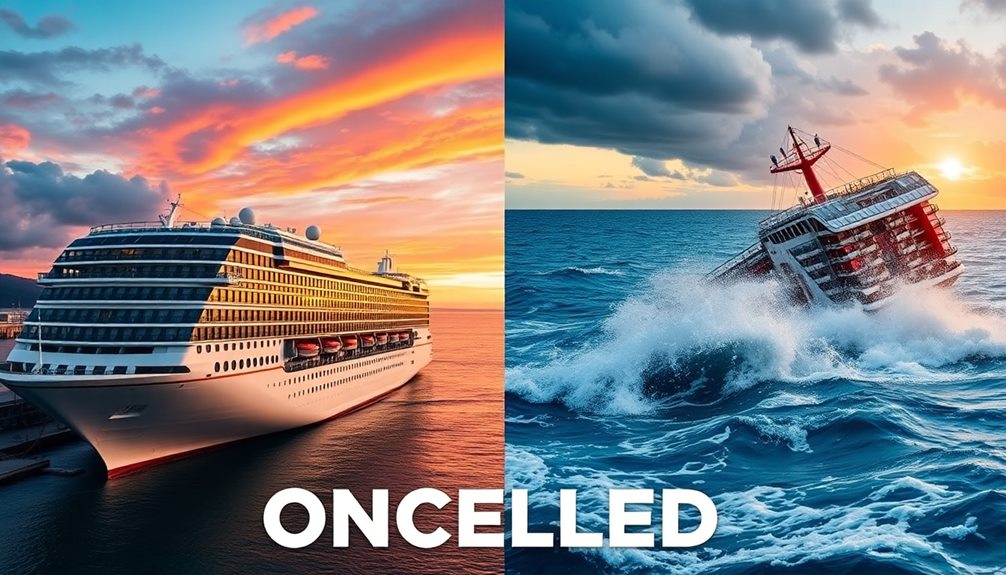
When you're planning a cruise, understanding cancellation policies can save you from unexpected fees. Different cruise lines, like Royal Caribbean and Norwegian, impose strict rules, especially for short voyages, with potential penalties reaching 100% if you cancel within 30 days. Others, like Viking, start with lower fees for early cancellations. It's essential to evaluate travel insurance options, which can provide relief if your plans change unexpectedly. Each line has unique terms, so reviewing their specific policies is important. There's a lot more to explore about these policies that can help you make an informed choice.
Key Takeaways
- Cancellation policies vary significantly, with short cruises often incurring 100% penalties if canceled within 30 days of departure.
- Royal Caribbean and Norwegian Cruise Line impose strict cancellation fees, emphasizing the importance of understanding specific terms.
- Longer cruises typically have tiered cancellation fees, starting at 25% for cancellations made well in advance.
- Travel insurance, especially "Cancel for Any Reason" options, can mitigate potential financial losses from cancellations.
- Written notice is usually required for refunds, and processing can take several weeks, highlighting the need for timely communication.
Overview of Cancellation Policies
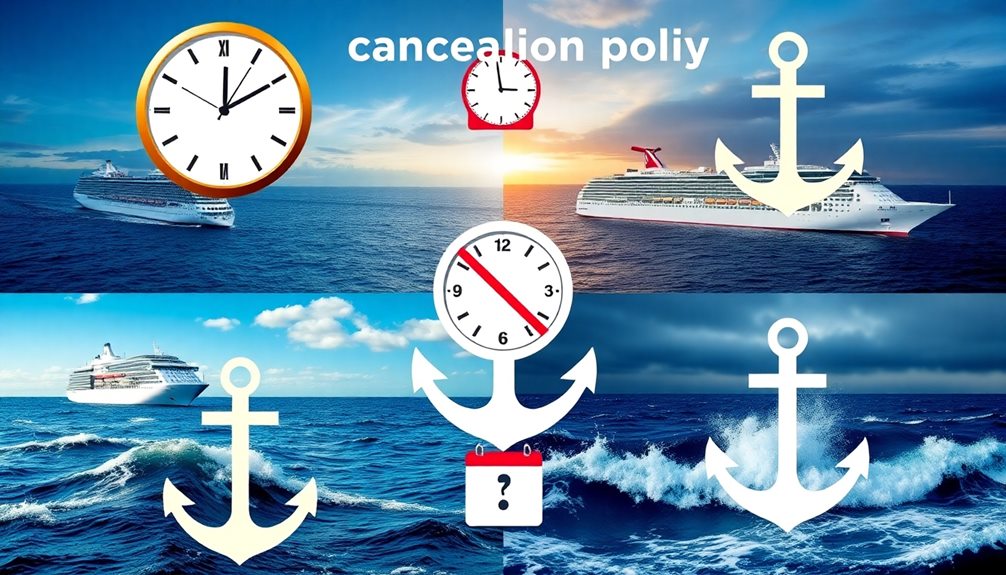
Steering through cruise line cancellation policies can feel like sailing through choppy waters, as they vary widely among different companies. Each cruise line has its own rules, which can complicate your planning. Many require a nonrefundable deposit when you book, meaning you could lose that money if you need to cancel.
For example, Royal Caribbean doesn't offer refunds for cancellations made within 30 days for cruises lasting 1-4 nights. If your cruise is longer, you're out of luck if you cancel within 24 days.
Norwegian Cruise Line has similar policies; significant cancellation fees kick in if you cancel within 30 days, especially for certain promotions that may carry nonrefundable fares.
Celebrity Cruises also imposes strict penalties, charging 100% for cancellations made 30 days or less before sailing for cruises of 4 nights or less.
If you're considering lines like Azamara or Silversea, be prepared for tiered cancellation fees that can reach 100% of your fare if you cancel close to your departure date.
Understanding these cancellation policies is essential to avoid unexpected costs.
Key Takeaways on Cancellations
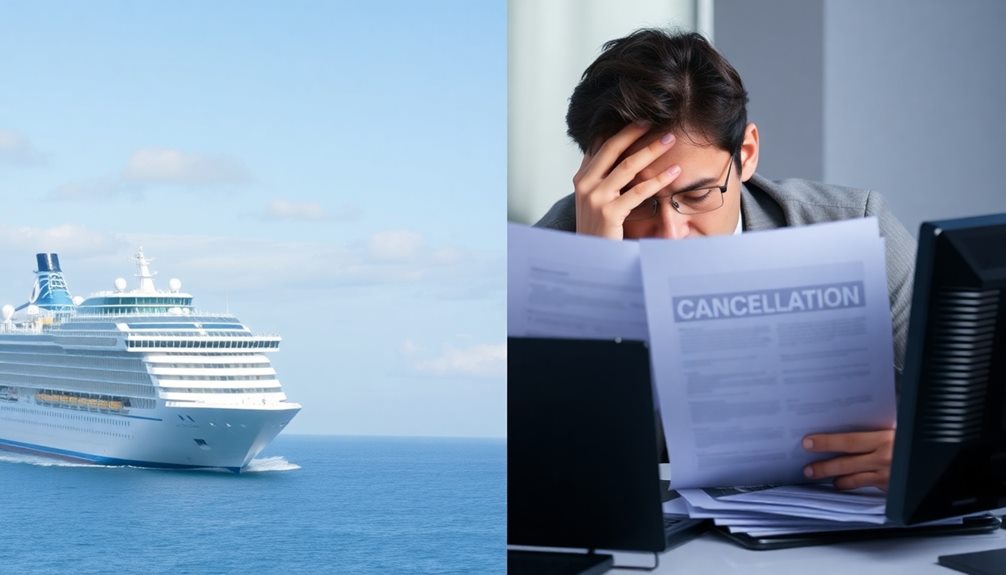
When planning your cruise, it's crucial to know that cancellation policies can differ widely among cruise lines.
Understanding these variations can save you from unexpected fees, especially as departure dates approach.
Plus, investing in travel insurance can provide peace of mind by covering potential losses if you need to cancel.
Policy Variations Across Lines
Cruise cancellation policies can catch travelers off guard, as they vary widely across different cruise lines. Many require a nonrefundable deposit, and cancellation fees can escalate quickly as your departure date approaches.
For cruises lasting four nights or less, if you cancel within 30 days, you might face penalties that reach 100% of your fare. For longer voyages, cancellation fees usually follow a tiered structure, often starting at 25% for cancellations made 89 to 75 days prior.
Some lines, like Carnival and Royal Caribbean, hit you with hefty fees for last-minute cancellations. Royal Caribbean, in particular, may offer no refunds for specific cruises if you cancel within 30 days.
On the flip side, some cruise lines, such as Viking Ocean Cruises, provide more lenient cancellation policies. They might only charge a $100 fee for cancellations made 120 days or more before sailing.
It's essential to review each cruise line's specific cancellation terms, especially since promotional fares may be nonrefundable.
Additionally, remember that prebooked items like excursions and spa treatments could incur separate cancellation fees, adding to your overall costs.
Importance of Travel Insurance
Understanding cancellation policies is just one part of planning your cruise. Travel insurance adds an essential layer of protection, especially if you're concerned about unforeseen events.
Policies like "Cancel for Any Reason" (CFAR) offer great flexibility, allowing you to cancel your trip for nearly any reason and receive a refund of 75%-90%, depending on the specific terms.
It's important to know that most CFAR policies must be purchased within a short window—typically 15-24 days after your initial payment. Always read the fine print to understand your refund options, as some might only offer future cruise credits.
Medical coverage is another significant aspect of travel insurance. Coverage can vary widely; for instance, Holland America Line offers limited secondary coverage of $10K, while Viking provides up to $100K.
Pre-existing condition clauses can also impact your coverage, so if you have known health issues, consider purchasing a policy with a waiver within the specified timeframe.
Understanding these nuances in travel insurance is essential for mitigating financial losses due to unexpected cancellations, ensuring your cruise experience remains enjoyable and stress-free.
General Cancellation Guidelines
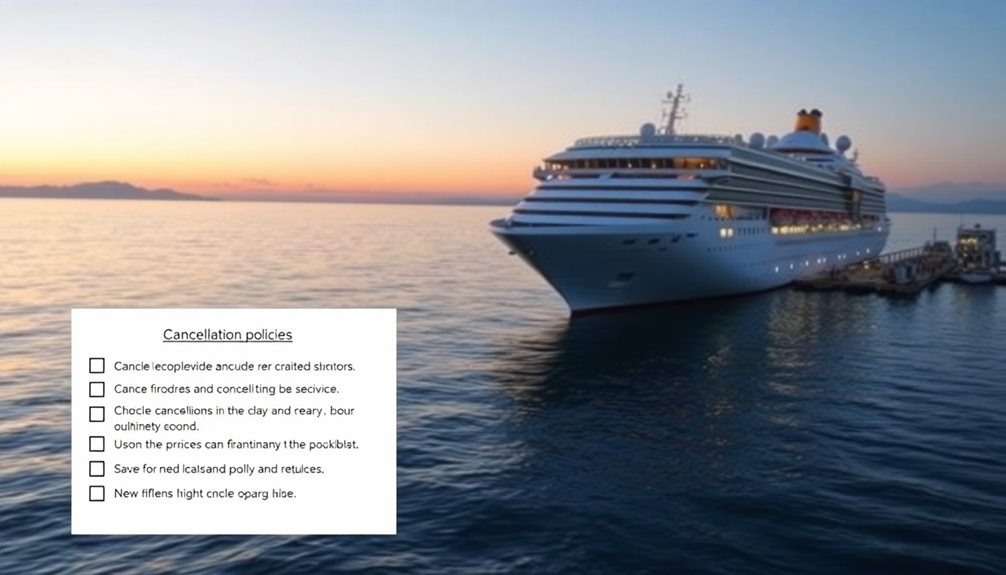
When it comes to cruise line cancellation policies, you'll find that rules can vary considerably between different companies.
Understanding the refund request procedures is essential, especially since some lines have strict deposit requirements.
Additionally, considering travel insurance can help you protect your investment against unexpected cancellations.
Policy Variations by Line
Each cruise line has its own set of cancellation policies, which can lead to confusion if you're not familiar with the specifics. Many lines require a nonrefundable deposit and impose cancellation fees that escalate based on how close you're to your departure date.
Here's a quick breakdown of what you might encounter:
- Cruises of 4 nights or less: Penalties can range from 50% to 100% of the fare if you cancel within 30 days.
- Cruises of 5 nights or longer: Fees typically start at 25% and can escalate to 100% as the sailing date approaches.
- Different policies by cruise line: Some, like Carnival and Royal Caribbean, have strict last-minute cancellation fees, while others like Azamara and Viking provide detailed tiered schedules outlining penalties based on the number of days before sailing.
Regardless of the line, you'll usually need to provide written notice of cancellation.
Keep in mind that processing times for refunds generally take about 3-4 weeks after you submit your request. Understanding these variations can help you navigate your options more effectively.
Refund Request Procedures
If you find yourself needing to request a refund for a canceled cruise, it's important to follow the specific procedures set by your cruise line. Most cruise lines require written notice for any refund requests, so make certain to submit your cancellation in writing.
Processing times usually take around 3-4 weeks, so patience is key. When submitting your request, include vital details like your booking reference and the reason for cancellation to prevent unnecessary delays.
If you're part of a group booking, be aware that specific terms may apply. Additional fees could be charged for name changes treated as cancellations.
It's also important to note that refund requests generally aren't applicable for no-shows or cancellations made after your cruise has started. As a result, understanding these policies before you book can save you headaches later on.
Always review the specific cancellation policy of your cruise line for any unique requirements or conditions related to refund request procedures. By following these guidelines, you can facilitate a smoother process in obtaining your refund.
Importance of Travel Insurance
Have you ever considered how unexpected events could derail your travel plans?
Whether it's a sudden illness or an emergency at home, these surprises can lead to significant financial loss if you're not prepared. That's why travel insurance is essential. It can cover unexpected cancellations, helping you recoup costs from nonrefundable deposits and hefty cancellation fees imposed by cruise lines.
Here are three key reasons to invest in travel insurance:
- Coverage for Unexpected Cancellations: Insurance can protect you from losing money if you need to cancel your trip due to unforeseen circumstances.
- "Cancel for Any Reason" Policies: These provide flexibility, allowing you to cancel for any reason and receive refunds of 75% to 90% of your trip cost.
- Enhanced Protection: Purchasing travel insurance soon after booking can improve coverage options and may waive pre-existing condition exclusions.
Understanding cancellation policies and the nuances of travel insurance can offer peace of mind before your cruise.
Don't wait—consider travel insurance as an important safety net for your next adventure.
Tiered Cancellation Fees
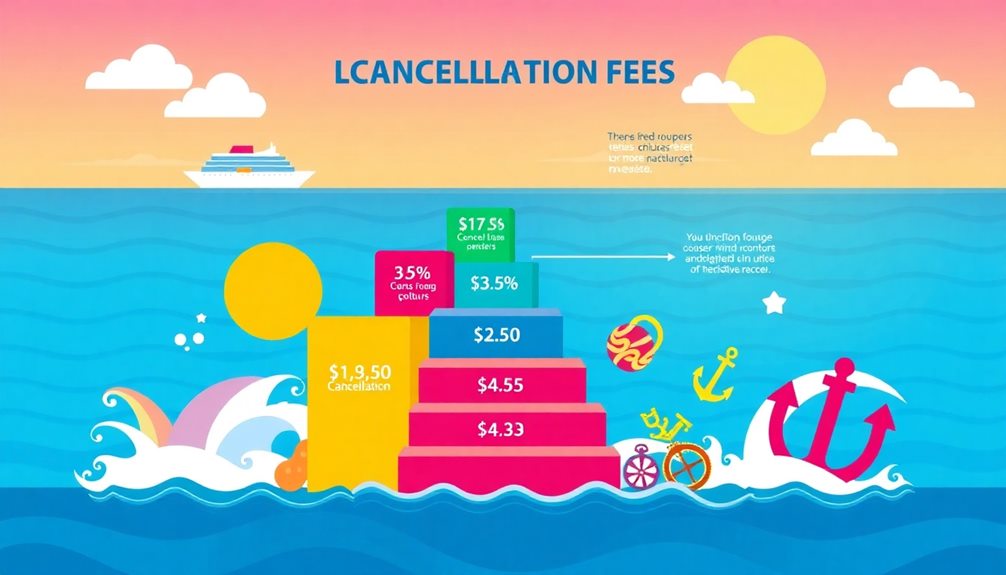
Cruise line cancellation policies often include tiered cancellation fees that can greatly impact your travel budget. These fees typically increase as your departure date approaches, meaning the closer you get to sailing, the more you'll pay if you need to cancel.
For example, if you're booked on a cruise of four nights or less, you could face a 100% cancellation fee if you cancel within 30 days. Cruises lasting five nights or longer have the same steep penalty during that time frame.
Some cruise lines, like Azamara, start charging 25% of your fare for cancellations made between 120 and 91 days before departure, escalating to full fare penalties for cancellations made within 30 days.
Carnival Cruise Line's cancellation fees vary based on the cruise's length, and last-minute cancellations often result in losing your entire fare.
Norwegian Cruise Line also has a structured fee schedule, emphasizing the importance of planning ahead and being aware of deadlines.
Cruise Line Specific Policies
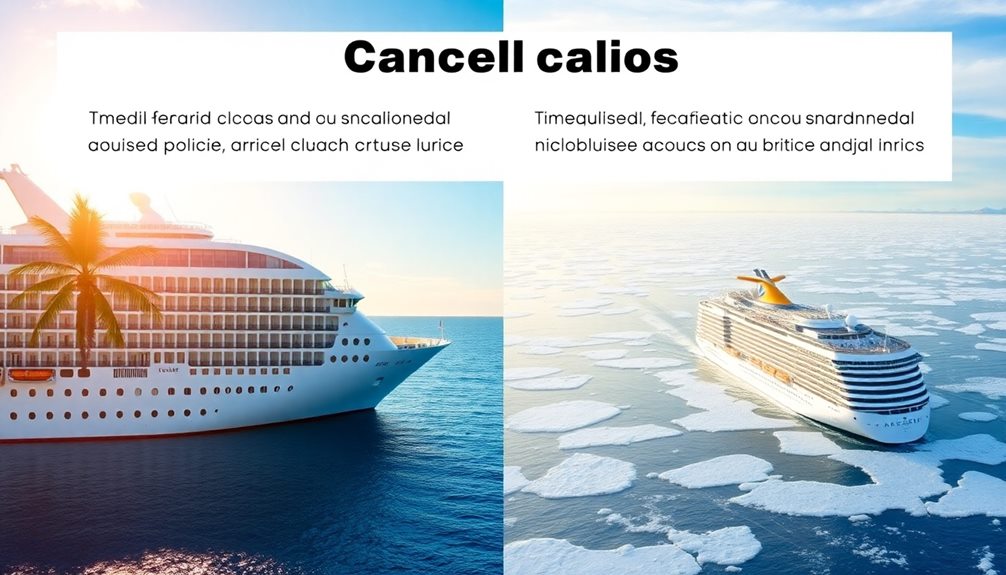
Understanding tiered cancellation fees is just the beginning when it comes to maneuvering cruise line specific policies. Each cruise line has its unique cancellation policies that can affect your plans and wallet.
Here's a quick overview of some key points:
- Royal Caribbean: They require a nonrefundable deposit. If you cancel within 30 days for cruises of 1-4 nights, you won't get a refund. For 5-14 night cruises, it's 24 days.
- Norwegian Cruise Line (NCL): Their cancellation fees depend heavily on how much notice you give. Cancelling within 30 days of departure can lead to significant penalties.
- Carnival Cruise Line: They implement tiered cancellation penalties that increase as your departure date nears. Last-minute cancellations can lead to hefty fees.
- Princess Cruises: Final payments are due 90 days before departure, and cancellation fees vary based on how close your cancellation is to your sailing date.
- Viking Ocean Cruises: They start cancellation fees at $100 per person for cancellations made 120 days or more before sailing, escalating to 100% of the fare if you cancel 29 days or less.
Being aware of these specific policies can help you navigate potential cancellation fees effectively.
Unique Policies by Selected Lines
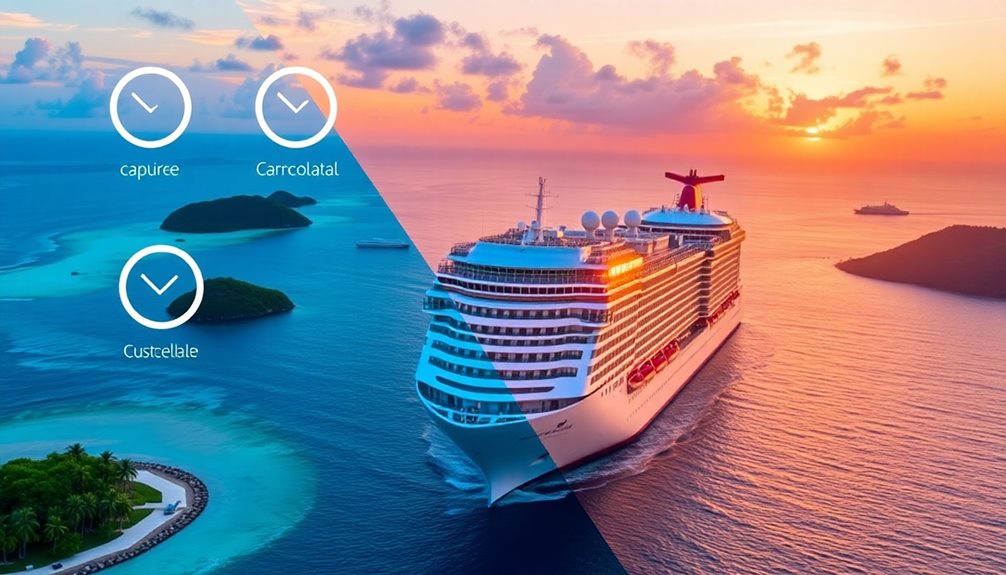
What unique cancellation policies should you consider when planning your next cruise? Each cruise line has its own set of rules that can profoundly affect your travel plans.
For instance, Azamara charges a 25% penalty for cancellations made 120 to 91 days before sailing and a steep 100% penalty for those made within 30 days.
Seabourn Cruise Line has a similar structure, with a 50% penalty for cancellations made 90 to 46 days prior, escalating to a full fare penalty within 30 days.
Viking Ocean Cruises offers a $100 fee for cancellations made 120 days or more in advance, but you'll face a 100% penalty if you cancel within 29 days.
Virgin Voyages presents a unique option: cancellations made 120 to 45 days before travel won't yield a refund, but you'll receive future cruise credit. If you cancel 44 days or less, however, you forfeit 100% of the fare.
Windstar Cruises has a more lenient approach, with a 15% penalty for cancellations made between 120 and 90 days, but a full fare penalty still applies within 29 days.
Be sure to review these cancellation policies to avoid unexpected penalties!
Financial Considerations for Travelers

When planning your cruise, financial aspects play a significant role in your overall experience. You need to evaluate several factors that can impact your budget, especially regarding cancellation policies and travel insurance.
Here are three key financial considerations:
1. Nonrefundable Deposits: Most cruise lines require a nonrefundable deposit. If you need to cancel, you could lose 25% to 100% of your investment, depending on when you cancel.
2. Travel Insurance: Investing in travel insurance is essential. Policies with "Cancel for Any Reason" (CFAR) coverage can be beneficial but often come with additional costs.
You'll want to weigh this expense against the potential financial loss of a cancellation.
3. Pre-existing Condition Clauses: Be aware that many travel insurance policies don't cover medical emergencies related to pre-existing conditions. This could lead to significant out-of-pocket costs if an unexpected situation arises.
Understanding these financial considerations can help you make informed decisions and protect your investment, ensuring a smoother cruise experience.
Plan ahead and be prepared for the unexpected!
Resources for Navigating Policies
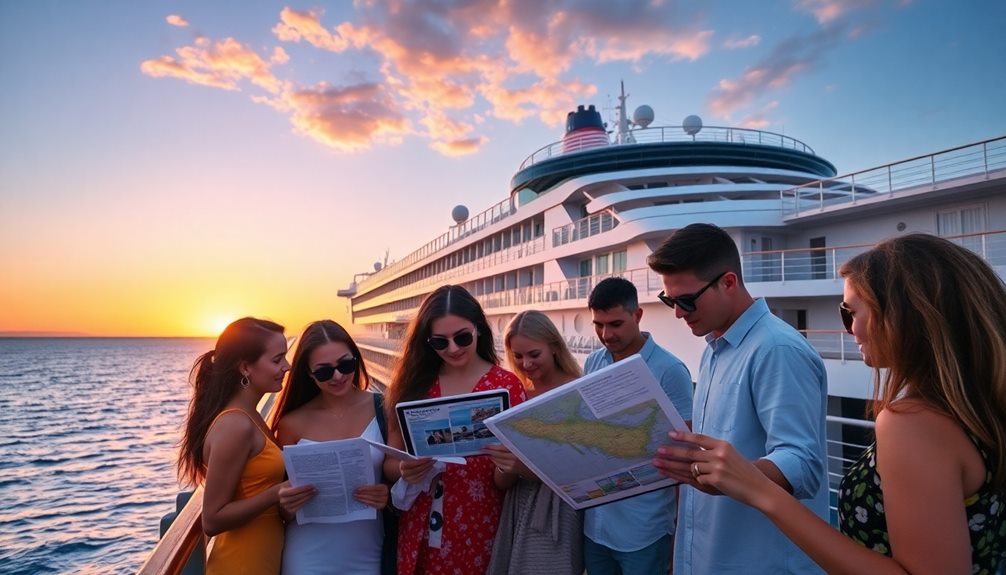
Maneuvering cancellation policies can often feel overwhelming, but various resources can simplify the process. Start by exploring cruise line websites and travel insurance comparison platforms. These sites provide a wealth of information on cancellation policies, including associated fees. Additionally, forums and travel blogs can offer invaluable insights from fellow travelers who share their experiences and recommendations.
Here's a quick overview of helpful resources:
| Type of Resource | Description |
|---|---|
| Cruise Line Websites | Direct details on cancellation policies |
| Travel Insurance Sites | Compare different travel insurance options |
| Travel Forums | Real-life experiences and tips |
| Blogs | Recommendations from seasoned travelers |
| Travel Agents | Tailored advice on policies and insurance |
Consulting with travel agents is essential, as they can guide you in selecting the right travel insurance, including "Cancel for Any Reason" policies that enhance your flexibility. Familiarize yourself with the specific terms in your booking confirmation and cruise line documentation, as this knowledge is significant for understanding the implications of cancellation policies.
Conclusion
To sum up, understanding cruise line cancellation policies can save you time and money. While some might worry that these policies are too complicated, a little research goes a long way. With tiered fees and specific guidelines, knowing your options can help you make confident decisions. Don't let the fear of cancellation hold you back from planning your dream cruise. By staying informed, you can navigate these policies and enjoy your journey with peace of mind.
Alfons is the visionary leader and driving force behind Voyager Info’s success. As the Editor in Chief, he brings a wealth of experience and an unwavering passion for travel to the helm of our cruise-centric platform.
With a lifelong fascination for exploring new horizons, Alfons discovered his love for the ocean and cruising at a young age. From sailing across pristine Caribbean waters to embarking on daring expeditions to far-flung destinations, he has amassed a treasure trove of first-hand experiences in the world of cruising.
Cruise Line Comparisons
Gratuity Policies Compared
Understand the complexities of gratuity policies across sectors and regions, revealing surprising insights that could change your perspective on tipping.
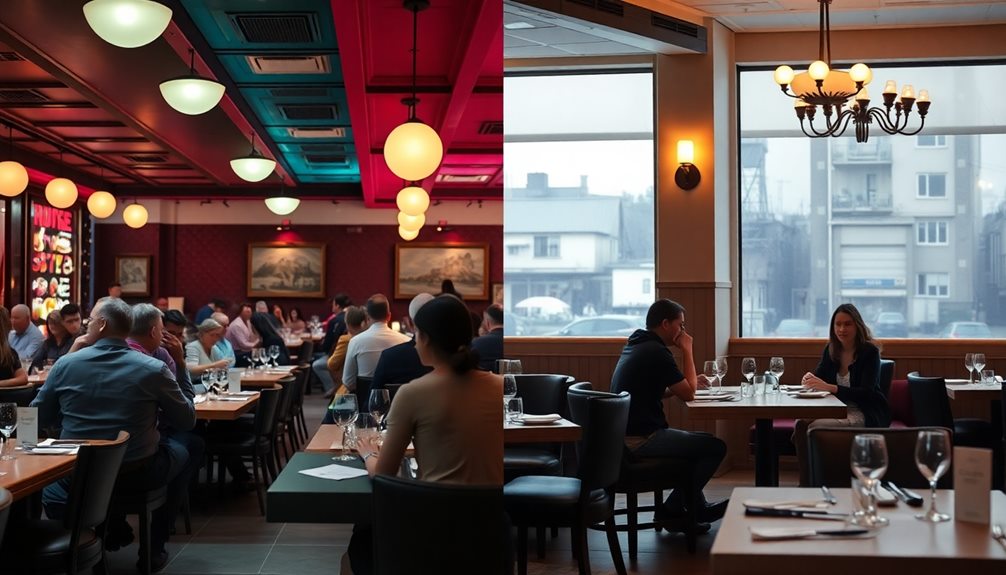
Gratuity policies can vary greatly between sectors and regions. In the service industry, for example, around 67% of Americans tip at sit-down restaurants, typically between 15% and 20%. However, tipping practices fluctuate, with only 20% tipping at coffee shops. Legal frameworks also differ; automatic gratuities are treated as wages in some states, affecting taxation. Understanding these nuances helps you navigate your career and financial planning better. You'll find that exploring alternatives like service charges and emerging compensation models can reveal even more about how gratuities impact both employees and customers alike.
Key Takeaways
- Gratuity policies ensure financial security for employees, with eligibility requiring a minimum of five years of continuous service.
- Traditional gratuity plans offer fixed benefits based on salary and service duration, while ULIPs provide market-linked returns.
- Automatic gratuities, typically 15-20% for large parties, are classified as wages in California and fully taxed.
- Gratuity payments are tax-free up to Rs. 20 lakh, promoting employee welfare and retirement planning.
- Income variability for tipped workers arises from fluctuating customer tips, complicating financial stability in the service industry.
Overview of Gratuity Policies
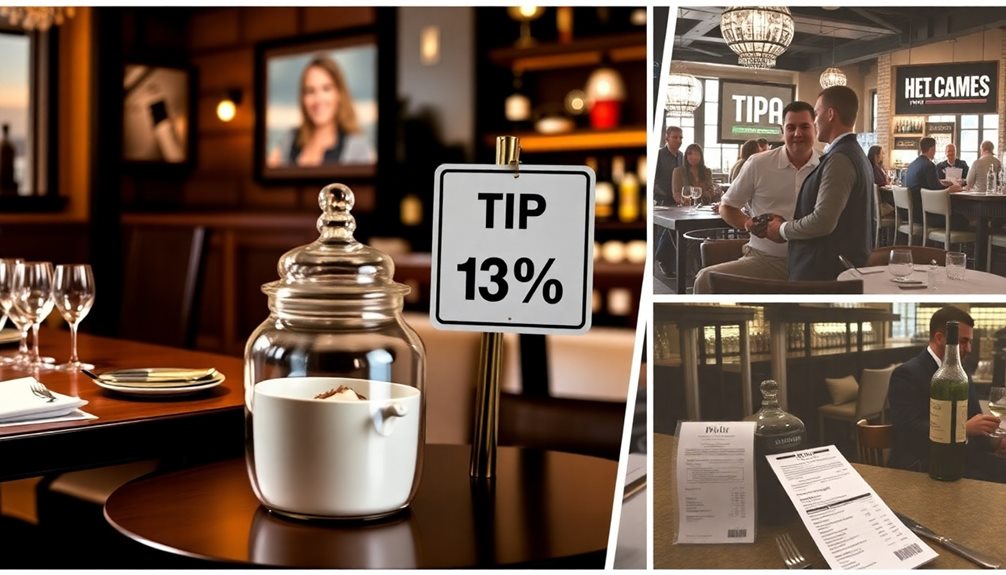
Understanding gratuity policies is essential for both employees and employers alike. Gratuity serves as a financial safety net for employees upon resignation, retirement, or death, providing a lump sum payment that acknowledges their service. According to the Payment of Gratuity Act, 1972, employees are eligible for gratuity after completing a minimum of five years of continuous service.
In organizations with ten or more employees, gratuity is calculated using a specific formula: Gratuity = (Last drawn salary × Number of years of service × 15) / 26, with a cap of Rs. 20 lakh. This guarantees that long-serving employees receive fair compensation for their dedication.
Employers are legally obligated to maintain a gratuity fund and disburse gratuity to eligible employees, reinforcing their commitment to employee welfare.
Additionally, the gratuity amount received is tax-free up to Rs. 20 lakh under Section 10(10) of the Income Tax Act, adding another layer of financial benefit.
In cases of an employee's death, the regulations guarantee that nominees receive the gratuity, highlighting the importance of understanding your rights and entitlements related to gratuity.
Types of Gratuity Systems
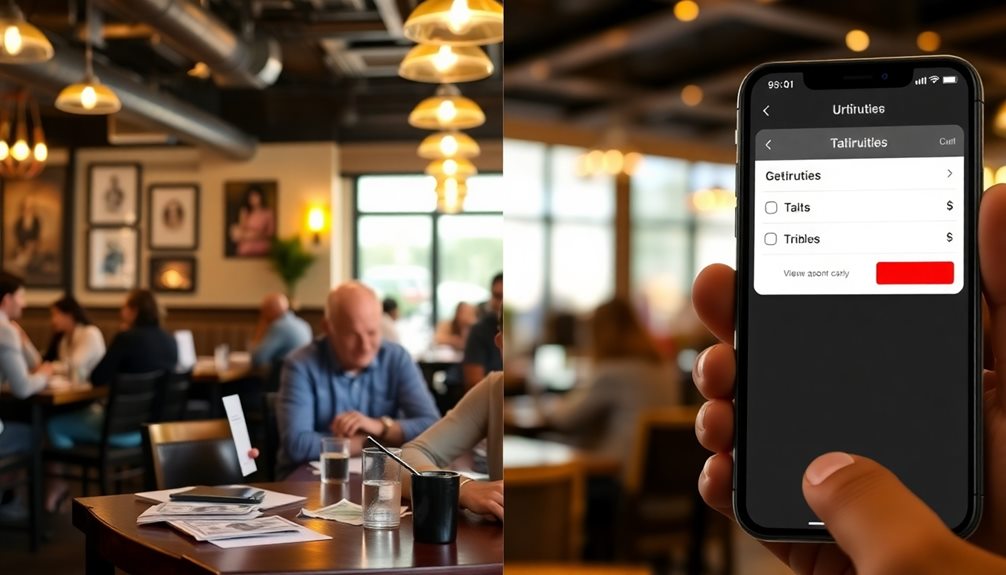
Gratuity systems come in various forms, each designed to meet differing financial needs and preferences. You might encounter traditional gratuity plans, which provide fixed gratuity benefits based on your last drawn salary and years of continuous service. These plans offer predictability, allowing you to plan your finances effectively upon retirement.
On the other hand, unit-linked plans (ULIPs) offer more flexibility with market-linked returns, allowing you to invest based on your risk appetite. If you're part of a large gathering, you may also experience automatic gratuity, a mandatory service charge that guarantees fair compensation for service staff.
Group gratuity schemes fall under the Payment of Gratuity Act, 1972, requiring a minimum of five years of continuous service for eligibility. If you prefer guaranteed returns, non-participating endowment plans can be a suitable option, offering predictable cash flows for those who favor conservative strategies.
When it comes to how gratuity is calculated, remember that it considers your last drawn salary and years of service, capped at INR 20 lakh under the Income Tax Act.
Each system serves different goals, so choose what aligns best with your financial strategy.
Legal Framework for Gratuities
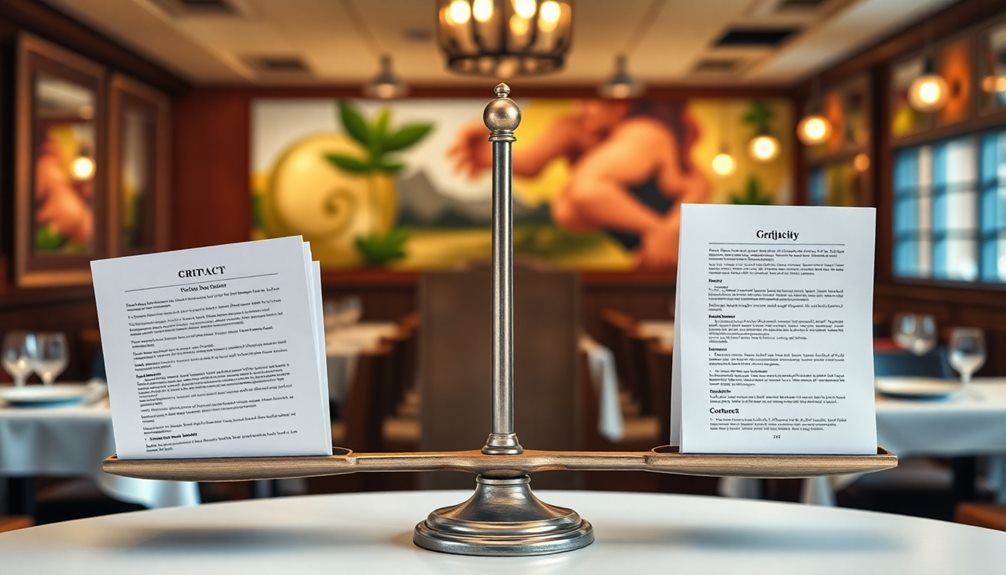
In many countries, gratuity systems are governed by specific legal frameworks that outline employee rights and employer obligations.
In India, the Payment of Gratuity Act, 1972 mandates gratuity payments for employees with at least five years of continuous service in organizations with ten or more employees. The formula for calculating gratuity is straightforward: Gratuity = (Last drawn salary × Number of years of service × 15) / 26, with a maximum tax-exempt payout capped at INR 20 lakhs.
In the U.S., gratuities take a different form, especially for tipped workers. Here, tips are seen as voluntary payments from customers and can be as low as $2.13 per hour, emphasizing their importance.
Automatic gratuities, often applied to large parties, are classified as wages for tax purposes and must adhere to federal and state regulations regarding their disclosure and distribution.
Furthermore, California's Labor Code Section 351 guarantees that tips and gratuities belong to employees, prohibiting employers from claiming any share. This legal framework safeguards your rights, including provisions for your legal heir to receive gratuity payments in case of your demise.
Comparison of Automatic Gratuity Practices
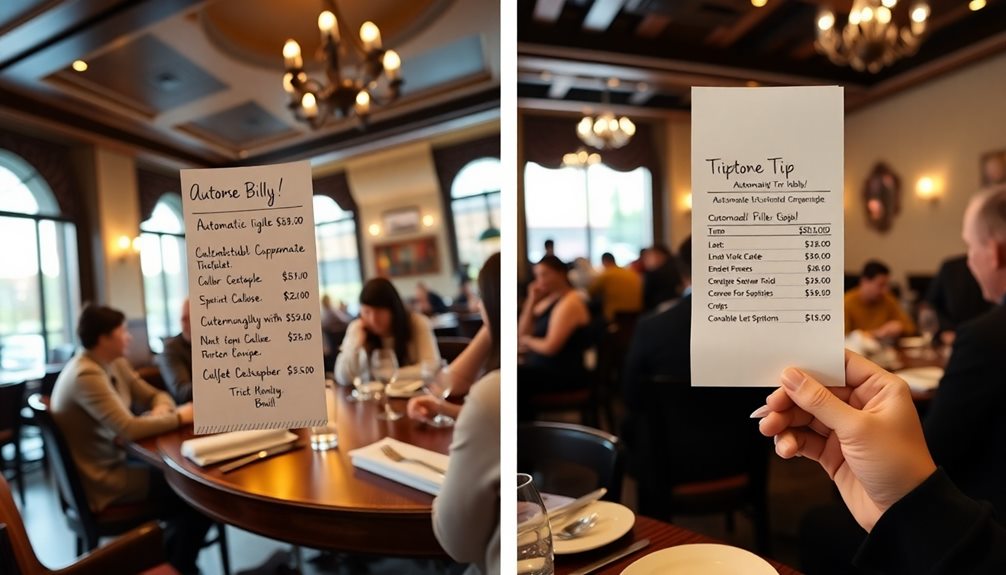
While many restaurants utilize automatic gratuities to guarantee fair compensation for their staff, practices can vary greatly across the U.S. Automatic gratuities, often ranging from 15% to 20% of the total bill before tax, are especially common for large parties. This approach helps mitigate the financial strain on servers during high-demand dining experiences. However, the treatment of these service charges can differ markedly depending on state regulations and IRS guidelines.
Here's a quick comparison of automatic gratuity practices:
| Aspect | California |
|---|---|
| Treatment | Considered wages |
| Tax Implications | Subject to full taxation |
| Distribution Requirement | Must be distributed fully to employees |
In contrast, many states allow restaurants to classify automatic gratuities differently, potentially leading to tax implications that can confuse guests and employees alike. Legal compliance is critical; mismanagement of automatic gratuity policies can trigger lawsuits over unclear charge distributions. Understanding these nuances can help you navigate dining experiences more effectively.
Economic Impact on Employees
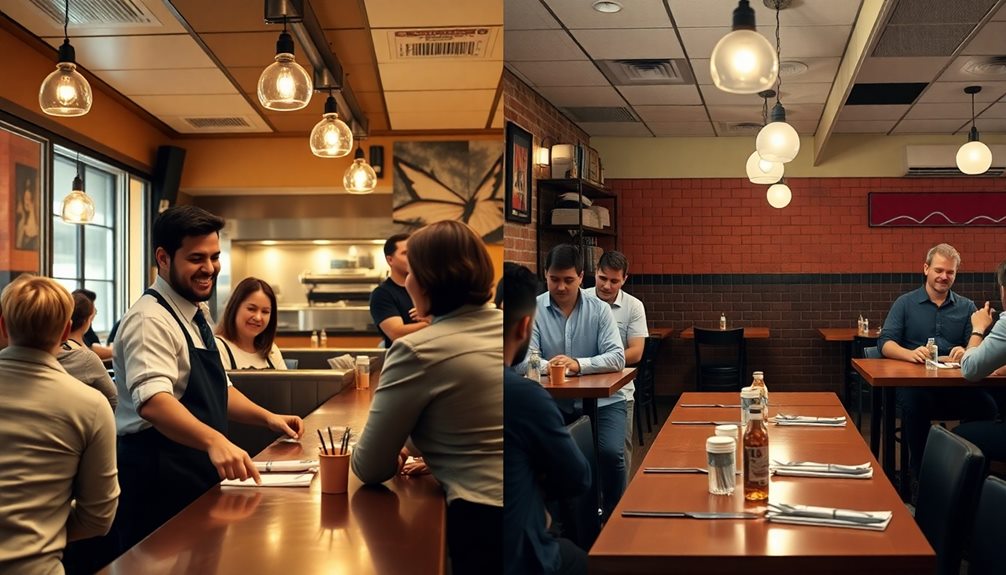
Gratuity payments can considerably smooth out the income variability you might experience in service industries with lower base wages.
By providing a lump sum after your tenure, it enhances your long-term financial security and helps you plan for retirement or unexpected costs.
Understanding how these payments work can empower you to make better career decisions and stay motivated in your job.
Employee Income Variability
Many employees in the service industry face significant income variability due to their reliance on tips, which often fluctuate based on customer generosity and seasonal demand.
With base wages as low as $2.13 per hour, many of you depend on gratuity amounts to meet your financial stability and address your employee needs. This reliance can lead to unpredictable income, making budgeting a challenge.
Here are three key factors that contribute to income variability for tipped workers:
- Customer Generosity: The amount you earn can change daily based on how generous customers feel.
- Seasonal Demand: During peak seasons, you may see a spike in tips, while off-peak times can lead to a drop in income.
- Tipping Confusion: With 11% of Americans unsure about tipping norms, unclear expectations can directly affect your earnings.
As you navigate this income landscape, it's crucial to understand how these factors can impact your overall financial situation.
The variability in your income can create stress and uncertainty, making it imperative to find ways to achieve greater financial stability.
Long-term Financial Security
Financial security becomes increasingly important as employees navigate the complexities of their careers. Gratuity is typically a fundamental element in guaranteeing this financial stability. As you accumulate years of service, your eligibility for gratuity grows, providing a lump sum payment that acknowledges your loyalty to the organization.
Under the Payment of Gratuity Act, 1972, you become eligible after five continuous years, assuring long-term employees receive tangible benefits upon departure. The amount you receive is calculated based on your last drawn salary and years of service, with a maximum tax-free limit of INR 20 lakhs.
This substantial financial support can greatly aid in your retirement planning, offering peace of mind during career shifts. Furthermore, gratuity schemes not only enhance your financial security but also incentivize your long-term commitment to an organization, contributing to workplace stability and productivity.
Employers benefit too, as they can claim tax deductions on gratuity contributions, allowing them to manage liabilities while promoting your welfare. Consequently, gratuity plays an essential role in fostering a supportive environment that rewards dedication and guarantees financial security for employees like you.
Tipping Culture Across Regions

Tipping culture varies widely across regions, and what's expected in one area might be frowned upon in another.
Your understanding of gratuity can shape your dining experience, especially as cultural attitudes towards tipping differ considerably.
It's important to know the local standards to guarantee you're showing appreciation appropriately.
Regional Variations in Tipping
Across the United States, tipping practices can vary widely, reflecting regional cultures and expectations. Understanding these regional differences can enhance your dining experience and guarantee you leave the appropriate gratuity for good service.
Here are three key points to take into account:
- Northeast vs. South: In the Northeast, you'll typically tip higher, averaging around 18-20%, while in the South, a range of 15-18% is more common.
- California's Urban Areas: If you're in California, especially in cities like Los Angeles or San Francisco, aim for around 20% due to the higher cost of living and service standards.
- Coffee Shops and Takeout: Tipping at coffee shops is generally lower, with only about 20% of Americans leaving a tip. Takeout food tips drop even further, averaging around 11%.
As digital payment systems become more prevalent, you might notice more options for tipping. However, confusion remains about who to tip and how much, with many feeling that tipping culture has become excessive.
Being aware of these regional variations in tipping can help you navigate service expectations confidently.
Cultural Attitudes Towards Gratuity
Cultural attitudes toward gratuity can shape your experience when dining out or receiving services. In the U.S., tipping norms vary considerably, with 67% of Americans tipping at sit-down restaurants but only 20% doing so at coffee shops.
You might find yourself confused about how much to tip, as the general guideline ranges from 15% to 20% for good service. However, specific expectations can differ, like 18-20% at bars and $5 or 20% for delivery drivers.
Interestingly, a notable 35% of Americans feel that the tipping culture has become excessive, reflecting growing concerns about increasing prompts for tips in non-traditional services. This highlights a shift in cultural attitudes toward gratuity, where many feel overwhelmed by the expectations surrounding it.
In fact, 11% of Americans are unsure about who to tip and how much, contributing to widespread consumer confusion.
Understanding these cultural attitudes can help you navigate the tipping landscape more confidently. By being aware of regional variations and common practices, you can guarantee your gratuities align with local customs and expectations.
Service Industry Standards Differ
Maneuvering the diverse landscape of service industry standards can be tricky, especially when it comes to tipping practices that vary from one region to another. Understanding local tipping norms is essential for anyone dining out or using services.
You might find that:
- Sit-down Restaurants: Tips typically range from 15% to 20%, reflecting the level of service provided.
- Takeout Food: Surprisingly, only about 11% of Americans consistently tip for takeout, which can leave tipped workers feeling undervalued.
- Coffee Shops: Just 20% of patrons regularly leave a tip, showing a clear disparity in expectations based on service type.
Additionally, the legal standards for service charges vary by state, which can further complicate things. Tipped workers often rely on gratuities for a significant portion of their income, sometimes earning as little as $2.13 per hour.
This reliance highlights the importance of being aware of local customs, as 35% of Americans believe the tipping culture has become excessive. By staying informed about these regional differences, you can navigate the tipping landscape more effectively and guarantee that you support workers fairly.
Employee Satisfaction and Gratuities

Gratuity policies play an essential role in shaping employee satisfaction within an organization. They provide not only financial security but also recognition for long-term service, enhancing loyalty and morale. When organizations implement structured gratuity plans, they typically see lower turnover rates, as employees feel valued and engaged. This connection between gratuities and employee satisfaction is vital for fostering productivity.
Here's a quick overview of how gratuity policies impact employee satisfaction:
| Gratuity Aspect | Employee Benefit | Organizational Impact |
|---|---|---|
| Financial Security | Provides stability for employees | Increases retention rates |
| Recognition | Acknowledges long-term service | Boosts morale and loyalty |
| Clear Communication | Enhances trust and understanding | Improves employee engagement |
| Tax Benefits | Tax-free up to INR 20 lakhs | Encourages commitment |
| Structured Plans | guarantees fairness and transparency | Reduces turnover |
Alternatives to Traditional Gratuities

Many restaurants are rethinking how they handle employee compensation by exploring alternatives to traditional gratuities. This shift can benefit both staff and customers, fostering a more transparent dining experience.
Here are three popular alternatives to evaluate:
- Service Charges: Instead of relying on tips, some restaurants are implementing service charges ranging from 15-22%. This allows owners to equitably distribute funds among staff, ensuring everyone feels appreciated for their hard work.
- Automatic Gratuity: For large parties or high-end services, automatic gratuity is frequently applied. This guarantees fair compensation for staff without leaving it to customer discretion, making the payment process smoother for everyone.
- Digital Tipping: As cash becomes less common, many establishments are adopting digital tipping methods, like Venmo or Zelle. This accommodates workers who prefer non-cash gratuities, allowing customers to tip conveniently while supporting their favorite servers.
Future Trends in Gratuity Policies

As the restaurant industry evolves, more establishments are shifting away from traditional tipping practices towards innovative compensation models. This trend is gaining momentum as service charges replace tips, promoting transparency in how service workers are compensated.
With increasing awareness and legal scrutiny around gratuity practices, employers are adopting clearer policies to guarantee compliance with laws regarding automatic gratuities and service charges.
You might also notice the rise of digital payment platforms influencing gratuity practices. Consumers now prefer cashless tipping methods, which affects how tips are collected and distributed among staff.
Companies are exploring structured gratuity plans, such as Group Gratuity Schemes, to better manage employee benefits and provide financial security for long-term service staff.
Moreover, as remote and gig work becomes more common, there's a growing push for standardized gratuity practices across various service sectors. This guarantees that all workers, regardless of their employment arrangement, are eligible for gratuity as a token of appreciation for their hard work.
These changes reflect a broader shift towards fairer treatment of service industry professionals in a rapidly evolving labor market.
Conclusion
In conclusion, understanding gratuity policies is essential for both employers and employees. As tipping practices evolve, it's clear that regional differences and economic factors play significant roles in shaping these systems. By keeping your ear to the ground, you can navigate the changing landscape of gratuities effectively. Whether you're embracing traditional tips or exploring alternatives, adapting to these trends will help guarantee that both you and your staff feel valued in the workplace.
Alfons is the visionary leader and driving force behind Voyager Info’s success. As the Editor in Chief, he brings a wealth of experience and an unwavering passion for travel to the helm of our cruise-centric platform.
With a lifelong fascination for exploring new horizons, Alfons discovered his love for the ocean and cruising at a young age. From sailing across pristine Caribbean waters to embarking on daring expeditions to far-flung destinations, he has amassed a treasure trove of first-hand experiences in the world of cruising.
Cruise Line Comparisons
Formal Night Policies: Line by Line
Master the art of cruise formal nights with essential guidelines for each line, but what unique policies might surprise you?

Understanding formal night policies is essential for your cruise experience. Each line has its own expectations. Generally, formal attire is required, like tuxedos or dark suits for men and evening gowns or cocktail dresses for women. Most lines have specific guidelines for dining venues where casual attire isn't allowed. Some cruises feature themed events adding a fun touch to formal nights. Pay attention to packing versatile outfits and accessories. Knowing the dress code ahead of time guarantees you feel confident and prepared. If you're curious about specifics for various cruise lines, there's plenty more to discover about their unique requirements.
Key Takeaways
- Formal nights typically range from 1 to 4 per cruise, varying by cruise line and itinerary.
- Men's attire generally requires tuxedos or dark suits, while women should wear cocktail dresses or evening gowns.
- Some cruise lines allow smart casual attire, but others maintain strict formal requirements for dining venues.
- Specialty restaurants enforce dress codes similar to the Main Dining Room, prohibiting casual and swimwear attire.
- Themed gala evenings provide additional fashion options and excitement, enhancing the overall formal night experience.
Overview of Dress Codes

When you set sail on a cruise, you'll likely encounter formal nights that require specific dress codes. These formal nights can vary between cruise lines and voyages, with one formal night typically scheduled for shorter cruises and up to four for lengthier journeys.
Understanding the formal dress code is crucial for enhancing your dining experience, particularly in venues like the Chef's Table.
Generally, acceptable options for formal attire include tuxedos, suits, cocktail dresses, and evening gowns. Some cruise lines uphold traditional formal nights, while others have relaxed their policies, allowing smart casual or elegant casual attire for most evenings.
For instance, Cunard hosts themed gala evenings, encouraging diverse fashion choices without strict requirements.
Regardless of the cruise line's specific rules, compliance with the formal night dress code is anticipated to elevate the overall ambiance on board. This attention to attire not only shows respect for the dining experience but also enhances the enjoyment of the evening's events.
Formal Night Expectations

Expect to embrace a more sophisticated atmosphere on formal nights, as these events are designed to elevate your cruise experience. Most cruise lines host formal nights at least once during a week-long voyage, with the number varying based on the cruise length. Adhering to the formal dress code is essential for all guests.
Here's a quick overview of what to expect:
| Men's Attire | Women's Attire | Dining Experiences |
|---|---|---|
| Tuxedos | Cocktail dresses | Main dining room |
| Dark suits with ties | Evening gowns | Chef's Table |
| Dress shoes | Elegant accessories | Specialty restaurants |
| No shorts or sandals | No casual wear | Reservations recommended |
| Clean, pressed clothing | Dressy flats | Formal ambiance |
Participating in these formal nights enhances your dining experience, particularly at exclusive venues like Chef's Table, where a formal dress code is enforced. You'll want to make reservations to enjoy these unique culinary offerings. So, pack your finest evening attire and get ready to indulge in a night of elegance!
Cruise Line Comparisons
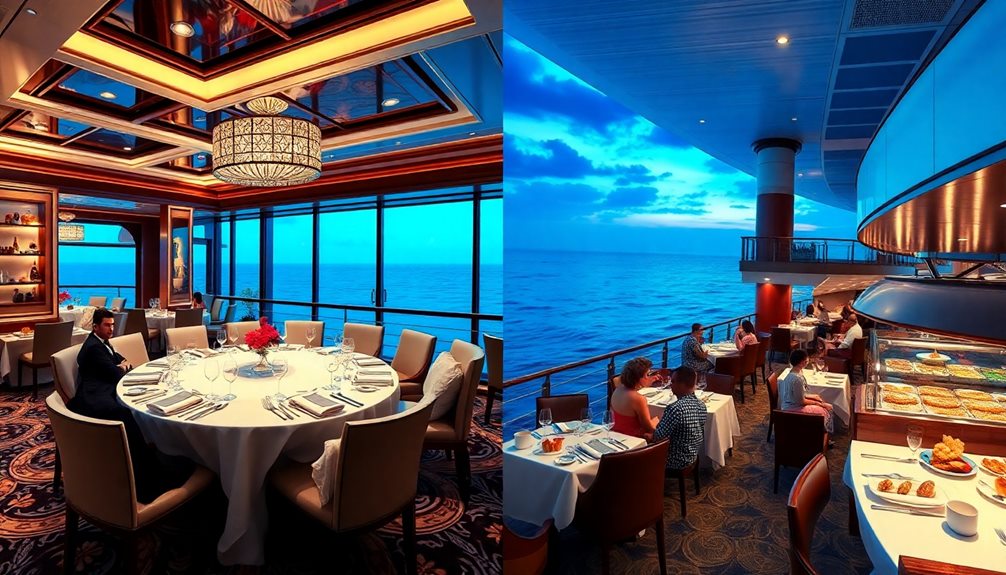
Cruise lines each have their own take on formal nights, offering a range of expectations that cater to different tastes and styles. Understanding these differences can help you prepare for your dining experience.
Here's a quick comparison of some popular cruise lines and their dress codes:
- Carnival Cruises: Expect 1-2 formal nights per cruise. Men typically wear dress pants, while women opt for casual dresses or skirts.
- Cunard: Known for its gala evenings, men are expected to wear tuxedos, and women usually don cocktail dresses. Don't miss themed events like the Black-and-White Ball!
- Royal Caribbean: Designated formal nights require men to wear suits or tuxedos, while women are encouraged to wear cocktail dresses, ensuring an elegant dining experience.
- Princess Cruises: They hold formal nights that mandate dinner jackets for men and evening gowns for women. On non-formal evenings, smart-casual attire is acceptable.
Keep these dress codes in mind as you plan your cruise! Each cruise line's approach to formal attire adds a unique touch to your overall experience, making it memorable.
Attire for Men

When it comes to formal nights, you'll want to contemplate appropriate attire choices like tuxedos or dark suits with ties.
Keep in mind that some cruise lines may have different dress code expectations, so check ahead for specifics.
Don't forget to polish your shoes and choose the right accessories to complete your look, as these details can elevate your dining experience.
Appropriate Formal Attire Choices
Formal nights on a cruise present an opportunity for men to dress with elegance and style. Most cruise lines expect you to adhere to a formal dress code, typically requiring tuxedos or dark suits with ties. This attire not only enhances your appearance but also enriches your overall dining experience, much like how K. Michelle's romantic history captivates her fans with intriguing details.
Here are some appropriate formal attire choices to evaluate:
- Tuxedos – A classic choice that exudes sophistication.
- Dark Suits – A versatile option that can be dressed up with the right accessories.
- Cufflinks – These small details can elevate your outfit considerably.
- Polished Shoes – A must-have to complete your polished look.
Keep in mind that some cruise lines, like Cunard, may host themed gala evenings, allowing you to showcase your unique style while sticking to the formal dress standards.
Dress Code Variability
During your cruise, you'll notice that dress code variability for formal nights can differ greatly between lines and even sailings. Most cruise lines expect men to don tuxedos or dark suits paired with ties, reflecting an elegant dining experience. However, the specifics can change depending on the cruise line and the length of your journey.
| Cruise Line | Dress Code Expectations |
|---|---|
| Cunard | Themed gala evenings; formal wear encouraged, but not strictly enforced. |
| Carnival & Royal Caribbean | Tuxedos or suits required; casual clothing like jeans is not permitted. |
| Norwegian Cruise Line | Flexible dress code; smart casual accepted on some formal nights. |
Typically, you'll find one formal night for cruises lasting 3 to 5 nights and up to four formal nights for longer sailings. This emphasis on formal attire not only enhances your experience but also creates memorable opportunities for photos. So, embrace the chance to dress up and enjoy the ambiance that these formal nights offer.
Accessories and Footwear Guidelines
To elevate your formal night attire, pay close attention to accessories and footwear. The right choices can make a significant difference in your overall look and confidence. Here's what you should consider:
- Polished Dress Shoes: Opt for polished dress shoes or loafers that complement your formal attire. Sneakers or casual shoes are a no-go in formal settings, so keep it sophisticated.
- Accessorize Wisely: Ties, bow ties, or cravats are essential to enhance your outfit. Dark or metallic colors are recommended for a classic touch that pairs well with any ensemble.
- Cufflinks: Don't forget to add cufflinks to your dress shirt. They're a stylish addition that adds a refined detail, elevating your overall appearance.
- Tailoring Matters: Confirm your jacket or tuxedo is well-fitted. A tailored outfit avoids a sloppy look and guarantees you present yourself at your best.
Attire for Women

Elegant attire is essential for women on formal nights, as it sets the tone for a sophisticated dining experience. You're encouraged to wear cocktail dresses or evening gowns that highlight elegance and sophistication. If you prefer, dressy skirts and blouses are also acceptable, allowing you to accessorize with jewelry for that extra flair.
While some cruise lines may permit smart casual options, adherence to formal attire is expected during these special evenings. Here's a quick guide to help you choose:
| Attire Type | Acceptable Examples | Prohibited Items |
|---|---|---|
| Cocktail Dresses | Short or knee-length styles | Jeans and shorts |
| Evening Gowns | Full-length elegant dresses | Flip-flops |
| Dressy Skirts and Blouses | Tailored tops with stylish skirts | Casual sundresses |
| Tailored Pantsuits | Chic trousers with blazers | Athletic wear |
Remember to select footwear that complements your outfit, ensuring a polished appearance throughout the night. By following these guidelines, you'll contribute to an atmosphere of refinement and elegance during formal nights.
Dining Room Restrictions
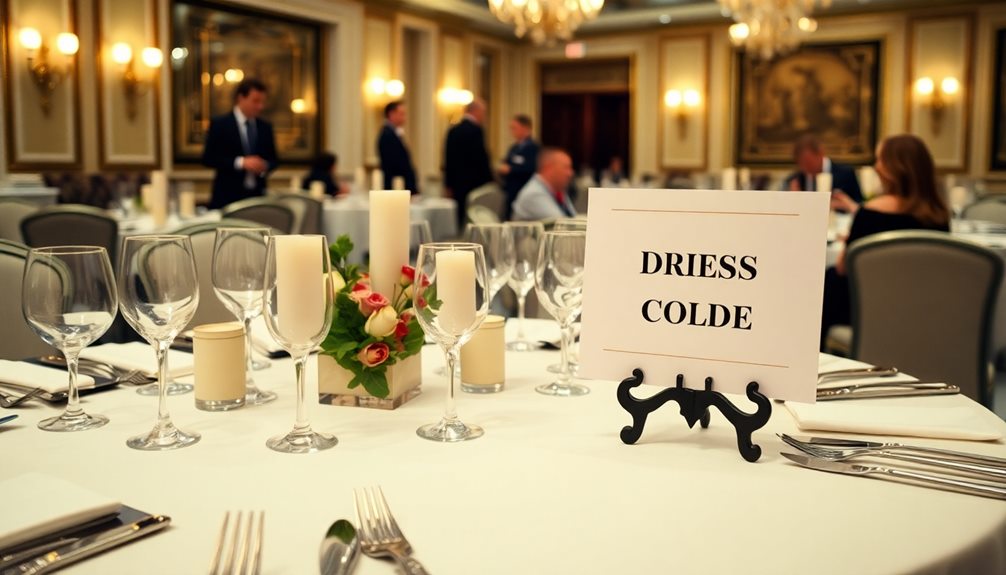
When you enter the Main Dining Room or Specialty Dining venues, you'll need to follow specific dress code restrictions.
Staff members are there to guarantee everyone complies, maintaining the dining experience's upscale atmosphere.
Dress Code Enforcement
Guaranteeing compliance with the dress code during formal nights is essential for maintaining the upscale atmosphere in the dining venues. It enhances your dining experience and sets the tone for a memorable evening.
Here's what you need to know about the dress code enforcement:
- Formal Attire: Men should wear black-tie attire, which includes suits or tuxedos, while women should opt for cocktail dresses or evening gowns.
- Restrictions: Bare feet and tank tops aren't allowed in the Main Dining Room or Specialty Dining venues, so plan accordingly.
- Varied Formal Nights: Depending on your cruise length, expect one to four formal nights, so be prepared with appropriate outfits.
- Monitoring Compliance: Staff will monitor adherence to the dress code and may issue reminders to guarantee everyone is dressed appropriately.
Particularly in experiences like the Chef's Table, compliance with the formal dress code is expected to enhance the meal's ambiance.
Dining Venue Expectations
Dining in the Main Dining Room and Specialty Dining venues comes with specific expectations to maintain a refined atmosphere. You'll want to embrace formal attire, especially on designated formal nights, which elevates your overall dining experience.
In these venues, wearing bare feet or tank tops isn't allowed, ensuring everyone contributes to the sophisticated environment.
Specialty Dining venues uphold a strict dress code similar to that of the Main Dining Room, so be prepared for the same level of formality. While casual dining options provide a more relaxed atmosphere, remember that swimwear is still prohibited. This policy helps maintain a level of decorum across all dining experiences.
Staff members are always on hand to monitor compliance with the dress code, and they'll issue reminders if necessary. It's crucial to respect these guidelines to enhance not just your experience but that of fellow guests as well.
Attire Compliance Monitoring
To maintain the elegant atmosphere of the Main Dining Room and Specialty Dining venues, compliance with the dress code is closely monitored by the dining staff.
Formal attire is preferred during formal nights, and it's crucial to adhere to these guidelines for an enjoyable dining experience.
Here are some key points to keep in mind:
- Dress Code: No bare feet or tank tops are allowed during dinner service.
- Formal Attire: Men should wear suits or tuxedos, while women are expected to don cocktail dresses or evening gowns on formal nights.
- Casual Dining: While casual dining venues permit more relaxed attire, swimwear is never acceptable in any dining location.
- Compliance Monitoring: Dining staff actively monitors adherence to the dress code. Non-compliance can lead to restricted access to certain areas, so it's crucial to follow the established guidelines.
Themed Events and Nights

Themed events and nights add an exciting layer to your cruise experience, making formal evenings feel even more special. Many cruise lines, like Cunard and Disney Cruise Line, host themed events during formal nights, encouraging you to participate in activities such as the Black-and-White Ball or themed dinner parties.
On longer Disney cruises, you can choose between formal or semi-formal attire, enhancing your overall dining experience with creative dressing.
Virgin Voyages takes it up a notch with their Scarlet Night party, where you're encouraged to wear trendy and vibrant outfits, adding a fun twist to the evening.
Other cruise lines, like MSC Cruises and Norwegian Cruises, offer optional theme nights. Here, you can dress according to suggested themes while enjoying a relaxed dress code, ensuring everyone feels comfortable while still embracing the theme.
These themed events often include special dining experiences or entertainment that aligns with the chosen theme.
By participating, you'll not only enhance your own experience but also create lasting memories alongside fellow guests who share in the festivities.
Immerse yourself in the fun and let the themed events transform your cruise nights!
Practical Packing Tips
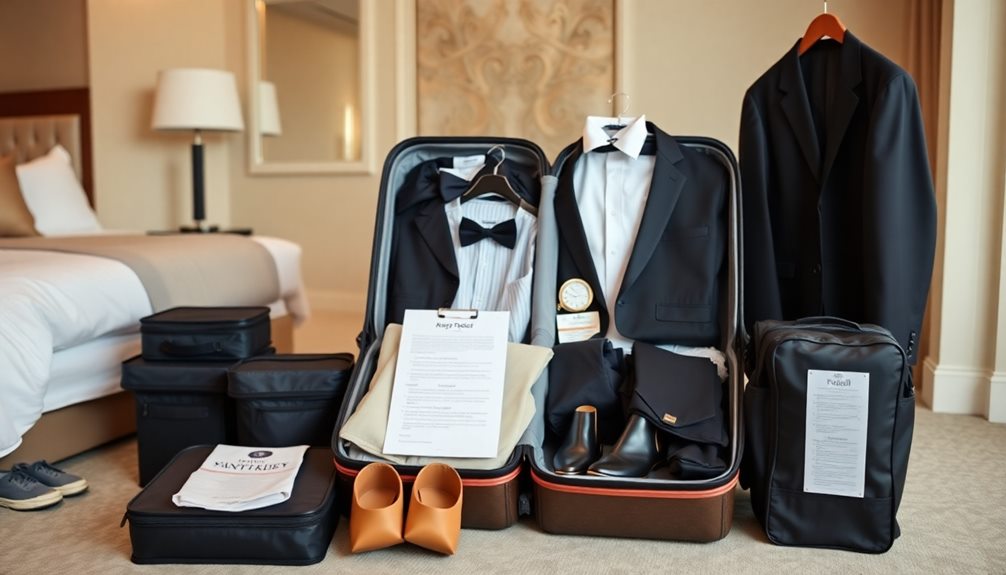
Packing for a cruise can be a puzzle, especially when formal nights are on the itinerary.
You'll want to guarantee you're ready for any dress code that comes your way. Here are some practical packing tips to make it easier:
- Prepare Your Outfits: Plan for 1 to 4 formal nights based on your cruise length. Make sure you've got a tuxedo or suit ready for men, and cocktail dresses or evening gowns for women.
- Choose Versatile Clothing: Pack pieces that can shift from daytime casual to smart casual or formal attire. This maximizes your luggage efficiency.
- Accessorize Smartly: Bring along ties, jewelry, and polished shoes that complement your formal outfits. These accessories can really enhance your overall look for those special evenings.
- Consider Climate: When selecting your formal attire, think about the climate and destination. Opt for breathable fabrics in warmer regions, or layer for cooler areas.
Lastly, always check your cruise line's specific dress code policies to confirm any unique requirements that could guide your packing decisions.
Happy cruising!
Tips for Local Port Attire

When cruising, you'll often visit local ports where appropriate attire can enhance your experience and show respect for the culture. Understanding the local customs and dress codes is essential to guarantee your attire aligns with expectations.
| Local Custom | Suggested Attire |
|---|---|
| Visits to churches | Modest dress; longer skirts or pants, sleeves covering shoulders |
| Caribbean nations | Avoid camouflage and military-style clothing |
| Daytime excursions | Lightweight, breathable fabrics, comfortable shoes |
| Evening dining | Versatile outfits that adapt well from day to night |
Research each port of call to avoid cultural faux pas. For churches or religious sites, modest dress is often required. In Caribbean countries, laws may prohibit certain styles, so steer clear of anything that resembles military gear. Lightweight fabrics keep you cool, while layers are handy for cooler evenings or air-conditioned venues. Consider packing versatile outfits that can seamlessly shift from daytime excursions to evening dining, confirming you're both comfortable and respectful. By following these tips for local port attire, you'll enhance your cruising experience while honoring the diverse cultures you encounter.
Conclusion
As you prepare for your formal nights at sea, remember that dressing well isn't just about fitting in; it's about embracing the grandeur of the experience. Think of it as your own star-studded premiere, where every outfit tells a story. So, pack those polished shoes and elegant dresses, and don't shy away from the themed events. With these tips in mind, you'll not only meet the dress code but also shine like the star you are.
Alfons is the visionary leader and driving force behind Voyager Info’s success. As the Editor in Chief, he brings a wealth of experience and an unwavering passion for travel to the helm of our cruise-centric platform.
With a lifelong fascination for exploring new horizons, Alfons discovered his love for the ocean and cruising at a young age. From sailing across pristine Caribbean waters to embarking on daring expeditions to far-flung destinations, he has amassed a treasure trove of first-hand experiences in the world of cruising.
Cruise Line Comparisons
Loyalty Program Benefits Comparison
Navigate the diverse landscape of loyalty program benefits to uncover which options truly maximize your rewards and elevate your travel experience.
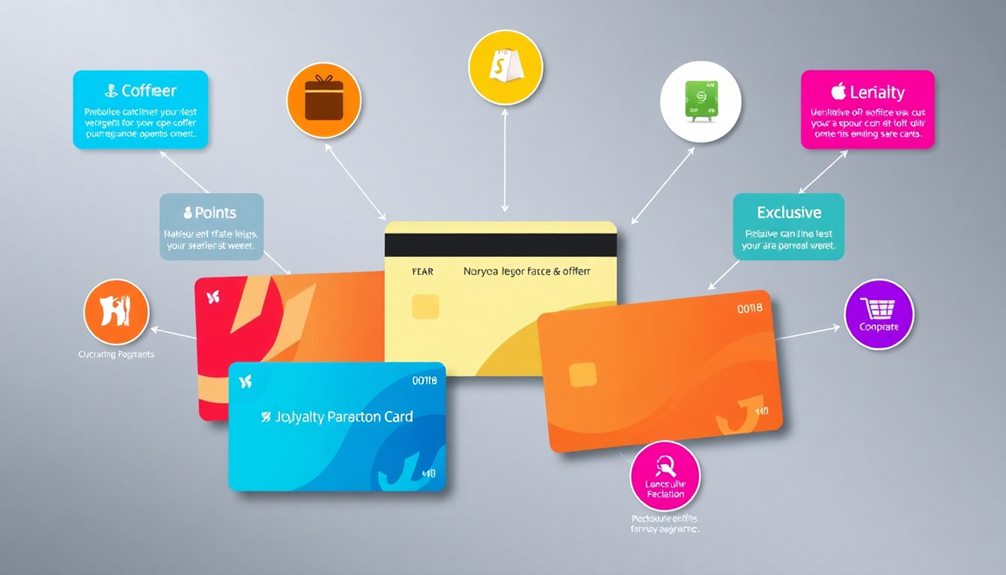
When comparing loyalty program benefits, you'll notice significant variations. Airline programs like Alaska Airlines and American Airlines offer valuable mile accumulation and elite status perks. Hotels like World of Hyatt excel with high point redemption values and exclusive amenities for elite members. Look for programs with flexible redemption options and high earning rates to maximize your rewards. Credit cards tied to these programs can boost your earning potential, providing added benefits for your everyday spending. By considering your travel priorities and spending habits, you can choose the best program that suits your needs. There's more to explore about optimizing your choices.
Key Takeaways
- Earning Rates: Compare programs based on how many miles or points are earned per dollar spent, as higher rates yield better rewards.
- Redemption Flexibility: Evaluate the variety of options available for redeeming points or miles, including travel upgrades, late check-outs, and partner bookings.
- Elite Status Perks: Consider the benefits offered to frequent travelers, such as room upgrades, priority boarding, and exclusive access to lounges.
- Public Rewards Transparency: Look for programs that provide clear information on earning and redeeming, simplifying trip planning and maximizing value.
- Credit Card Integration: Assess how co-branded credit cards enhance earning potential with bonuses and everyday spending rewards tied to loyalty programs.
Overview of Loyalty Programs

Loyalty programs serve as a powerful tool for brands to foster customer allegiance and enhance travel experiences. These programs, including frequent flyer programs and hotel rewards, incentivize you to travel more and spend wisely. By joining an airline loyalty program, you can earn miles through flights and everyday purchases, ultimately allowing you to redeem miles for free flights and other travel rewards.
Major airline loyalty programs like Alaska Airlines Mileage Plan and American Airlines AAdvantage offer enticing program benefits, including elite status perks that elevate your travel experience. Perks such as priority boarding and bonus miles for partner airline flights can make a significant difference on your journeys.
Hotel loyalty programs, such as World of Hyatt and Marriott Bonvoy, also provide valuable point earning potential. You can earn points that translate into flexible redemption options, including room upgrades and late check-outs.
Many of these programs are free to join, and you can boost your earning potential through co-branded credit cards, which often feature substantial sign-up bonuses.
Understanding the specific benefits and earning potential of each loyalty program can greatly impact your overall travel savings and satisfaction.
Selection Criteria for Programs
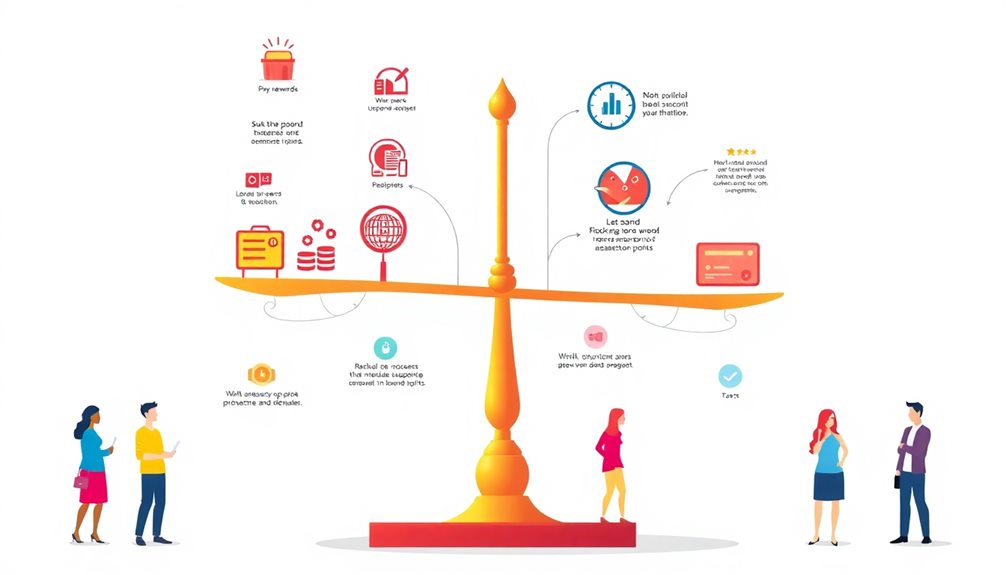
When evaluating loyalty programs, you'll want to reflect on several key criteria that can impact your overall experience and rewards. Understanding these factors helps you maximize your benefits, whether you're a casual traveler or one who frequently flies.
Here are four essential criteria to contemplate:
- Earning Rates: Look at how many miles you can earn per dollar spent. Higher earning rates can greatly boost your rewards.
- Redemption Options: Examine the flexibility of how you can use your miles. Programs with varied redemption options offer greater value.
- Elite Status Perks: If you're a frequent traveler, reflect on the elite rewards associated with a program. These can include upgrades, priority boarding, and special discounts.
- Public Rewards Search: Verify the program has a transparent public rewards search feature, making it easy to plan your trips and understand your options.
Top Airline Rewards Programs
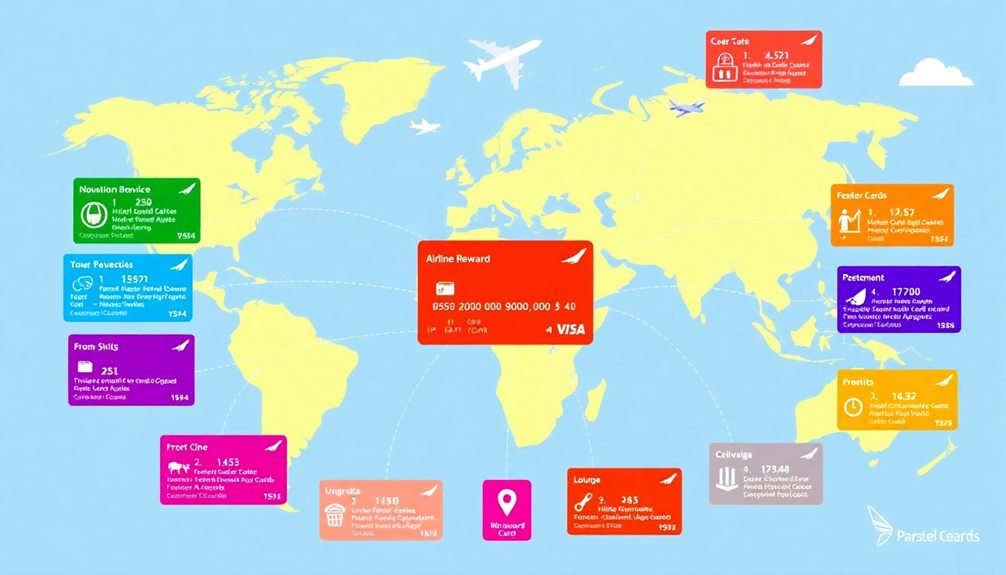
Evaluating the best airline rewards programs can greatly enhance your travel experience and maximize the benefits you receive. The Alaska Airlines Mileage Plan stands out as the top choice, valued at 1.3 cents per mile, thanks to its distance-based earning structure.
If you're drawn to Hawaii, consider Hawaiian Airlines' HawaiianMiles, which ranks second with modest spending requirements and a solid value proposition.
The American Airlines AAdvantage program also shines, offering extensive earning opportunities through various partners, giving you more ways to accumulate rewards points.
Delta SkyMiles allows you to earn miles on both flights and everyday purchases but ranks lower than its competitors regarding value.
While Southwest Airlines and Spirit Airlines focus on low fares, they rank lowest in the rewards program comparison due to limited earning potential for frequent travelers.
If you're serious about maximizing your travel rewards, understanding elite status requirements and how to effectively earn and redeem miles is essential.
Choose the right frequent flyer program, and you'll enjoy a more rewarding travel experience!
Leading Hotel Rewards Programs
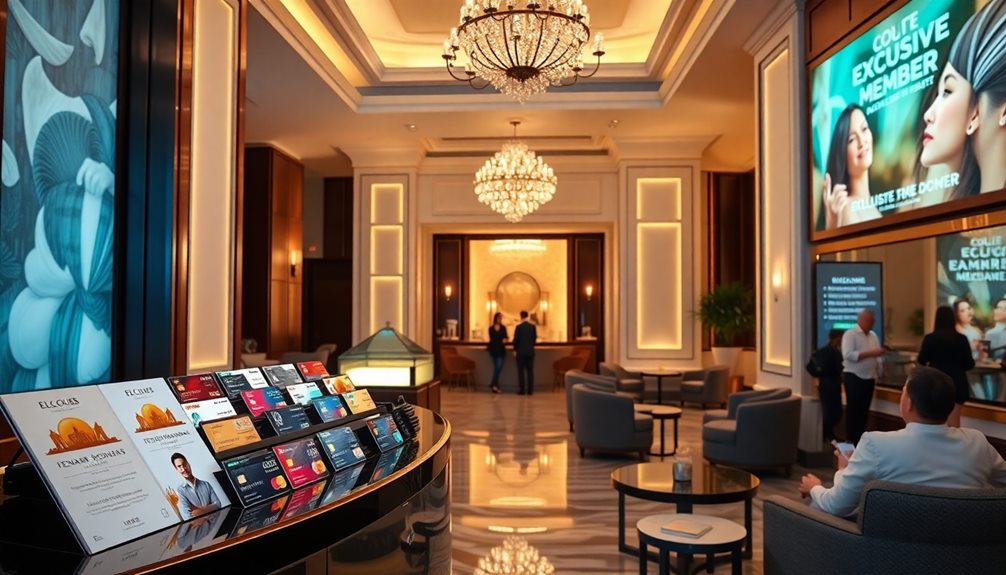
For travelers seeking to maximize their stays, leading hotel rewards programs can greatly enhance both the experience and value of your accommodations. The World of Hyatt program stands out as the best, offering strong redemption value at 2.2 cents per point and enticing elite status perks.
If you're a frequent traveler, you'll appreciate the benefits, which include room upgrades and exclusive event access.
Here are some top hotel rewards programs to evaluate:
- World of Hyatt – Best overall with excellent redemption value and perks for elite members.
- Choice Hotels – Ranks second, providing significant value for budget-conscious travelers with a solid rewards system.
- Marriott and IHG – Major brands that, surprisingly, scored lower despite their extensive global options.
- Best Western – Last on the list, aligning with its budget branding but offering fewer rewards advantages.
Choosing the right program guarantees your hotel stays are rewarding, making each trip feel like a true investment in your travel experiences.
Earning and Maximizing Rewards
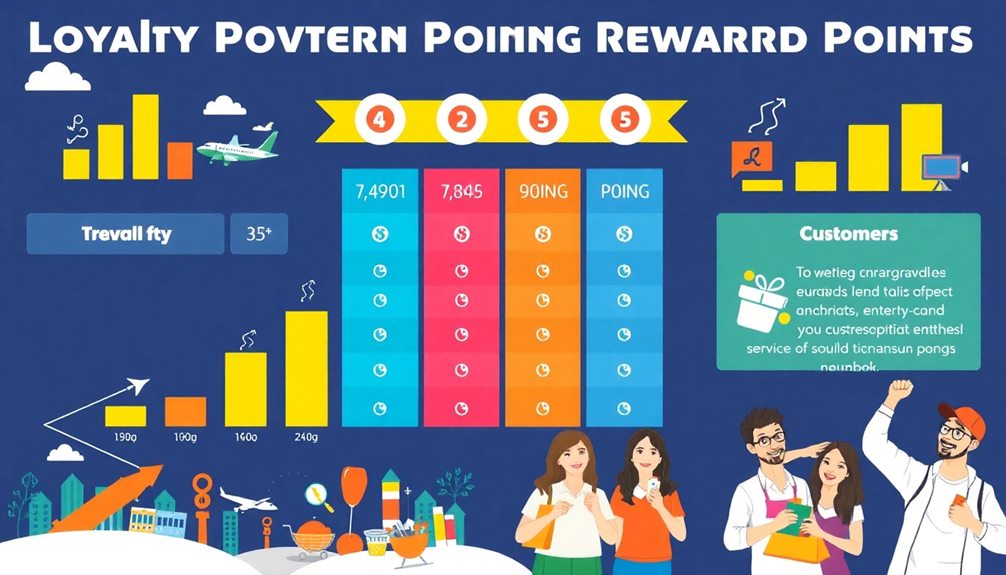
When it comes to earning and maximizing rewards, knowing the best strategies can make a big difference.
You can rack up points through flights, hotel stays, and even everyday purchases, especially with the right credit card.
Plus, by taking advantage of promotions and smart redemption options, you'll get the most bang for your buck.
Effective Earning Strategies
Maximizing your rewards in loyalty programs requires a strategic approach to earning. By implementing effective earning strategies, you can notably boost your loyalty points and miles.
Here are four key tactics to take into account:
- Utilize Travel Credit Cards: Opt for cards like the Alaska Airlines Visa Signature® or World of Hyatt Credit Card. They often offer substantial sign-up bonuses and additional points on travel-related purchases.
- Engage in Promotions: Keep an eye out for promotions that offer double or triple miles. These limited-time offers can greatly enhance your earning potential.
- Consolidate Credit Card Spending: Use specific credit cards for purchases in bonus point categories, such as dining or travel. This can lead to faster accumulation of miles.
- Partner with Affiliates: Make bookings through partner services like hotels and car rentals. This allows you to earn rewards across multiple platforms, effectively boosting your loyalty points.
Maximizing Redemption Options
Effective earning strategies lay the groundwork for reaping the full benefits of loyalty programs, but knowing how to maximize redemption options is equally important. You can enhance your rewards by utilizing co-branded credit cards, like the Alaska Airlines Visa Signature® or World of Hyatt Credit Card, which offer substantial bonuses. Keep an eye out for promotions that allow you to earn double or triple miles during specific periods.
Consider booking travel during off-peak times to take advantage of lower mileage requirements. Engage with shopping portals linked to your loyalty program; they let you earn extra miles for everyday purchases, making your spending work harder for you. Also, explore points transfer options with travel partners to maximize flexibility and value.
| Redemption Strategy | Benefits | Tips |
|---|---|---|
| Co-branded Credit Cards | Earning bonuses on everyday purchases | Choose cards aligned with your goals |
| Promotions | Double or triple miles opportunities | Act fast on limited-time offers |
| Off-Peak Travel | Better redemption rates | Research off-peak periods |
| Shopping Portals | Extra miles for partner retailer purchases | Always check before buying |
Insights on Program Benefits
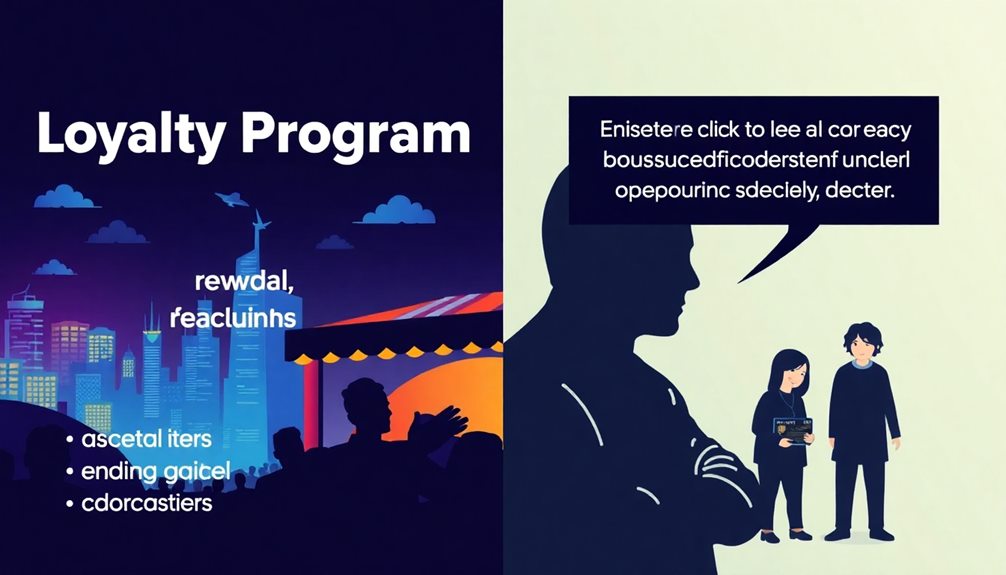
Loyalty programs offer travelers various benefits that can greatly enhance their travel experiences. By understanding these program benefits, you can maximize your rewards and enjoy more flexibility in your travels. Here are some key insights:
- Earning Miles: Programs like Delta SkyMiles allow you to earn miles not just through flights but also with everyday purchases, which accelerates your ability to accumulate travel rewards.
- Elite Status: With programs like World of Hyatt, you can enjoy substantial perks when you reach elite status, enhancing your hotel stays with benefits like room upgrades and late checkouts.
- Flexibility: Southwest Rapid Rewards stands out with no blackout dates, giving you the freedom to redeem points without worrying about availability restrictions.
- Partner Network: American Airlines AAdvantage provides access to a strong partner network, allowing you to earn and redeem points with various airlines globally, further expanding your travel options.
Recommendations for Travelers

Choosing the right loyalty program can greatly enhance your travel experience and rewards potential. If you're a frequent flyer, consider the Alaska Airlines Mileage Plan. With miles valued at 1.3 cents each and earning opportunities on over 30 partner airlines, it's perfect for maximizing your travel rewards.
American Airlines AAdvantage offers extensive earning possibilities through flights and cobranded travel credit cards, giving you flexibility in how you accumulate rewards.
For those who prefer simplicity, Southwest Rapid Rewards is a standout choice. Its straightforward points system allows you to earn without blackout dates, making redemption options clear and hassle-free.
If hotel stays are more your focus, the World of Hyatt program shines with high point values—2.2 cents each—and valuable elite status perks that enhance your stays.
Lastly, don't overlook the power of travel credit cards like the Alaska Airlines Visa Signature® or the World of Hyatt Credit Card. These cards can remarkably boost your earning miles through generous sign-up bonuses and everyday spending incentives.
Choose a loyalty program that aligns with your travel habits, and watch your rewards grow!
Conclusion
In the world of travel, loyalty programs can feel like a treasure hunt, with each point bringing you closer to your next adventure. By carefully selecting the right program and maximizing your rewards, you'll access benefits that enhance your journeys. Whether you're flying high with airlines or relaxing in luxurious hotels, the right loyalty program can turn your travel dreams into reality. So, why not plunge in and start reaping the rewards today? Your next getaway awaits!
Alfons is the visionary leader and driving force behind Voyager Info’s success. As the Editor in Chief, he brings a wealth of experience and an unwavering passion for travel to the helm of our cruise-centric platform.
With a lifelong fascination for exploring new horizons, Alfons discovered his love for the ocean and cruising at a young age. From sailing across pristine Caribbean waters to embarking on daring expeditions to far-flung destinations, he has amassed a treasure trove of first-hand experiences in the world of cruising.
-

 Port Guides2 months ago
Port Guides2 months agoCozumel Port Guide: Best Beach Clubs for Cruisers
-

 Port Guides2 months ago
Port Guides2 months agoSan Juan Port Guide: Hidden Gems Within Walking Distance
-

 Port Guides4 weeks ago
Port Guides4 weeks agoVirgin Gorda Port Guide: The Baths Access
-

 Port Guides2 months ago
Port Guides2 months agoGrand Cayman Port Guide: Tender Process and Best Activities
-

 Port Guides1 month ago
Port Guides1 month agoSt. Barts Port Guide: Luxury Shopping Tips
-

 Port Guides2 months ago
Port Guides2 months agoSt. Thomas Port Guide: Shopping and Beach Combinations
-

 Port Guides1 month ago
Port Guides1 month agoGrand Turk Port Guide: Best Beach Spots
-

 Port Guides1 month ago
Port Guides1 month agoPuerto Plata Port Guide: Cable Car Experience















